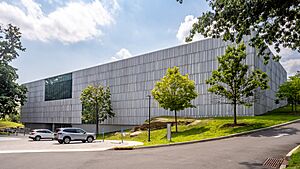Bruce Museum facts for kids
 |
|

The New Bruce (2024)
|
|
| Established | 1912 |
|---|---|
| Location | 1 Museum Drive Greenwich, Connecticut, United States |
| Type | Art, science, natural history |
| Public transit access | |
The Bruce Museum is a fantastic place in Greenwich, Connecticut. It's like three museums in one! You can explore amazing art, learn about science, and discover natural history here. People sometimes call it 'The Bruce' or 'The New Bruce'.
The museum's main building sits on a hill in a park. Its tall tower can be seen from Interstate 95. Inside, you'll find cool exhibits. These include sparkling minerals and stories about local Native American history. You can also see how humans have changed the local landscape. There are even dioramas showing Connecticut's woodland animals and birds. The museum often changes its exhibits. You might see new art, photos, or learn about different science topics.
The Bruce Museum also has a second spot called the Bruce Museum Seaside Center. It's located at Greenwich Point Park. This center focuses on beach-related exhibits. It even has a touch-tank where you can gently feel sea creatures! The museum also has a "Brucemobile." This is a traveling van with exhibits. It helps bring learning to schools and communities. The museum often hosts talks, classes, and fun events. For over 40 years, it has held a local arts festival. This festival is known across the country for its amazing fine arts.
Between 2020 and 2023, the museum became much bigger. It tripled its size! This new part is called The New Bruce. It has three floors and over 43,000 square feet of space for exhibits. This expansion includes the Steven & Alexandra Cohen Education Wing. It also has the William L. Richter Art Wing.
Contents
Discovering Art at The Bruce
The museum's art collection is very special. It has many paintings from the Cos Cob Art Colony. This was a group of artists who painted in an Impressionist style. You can see works by famous artists like Childe Hassam and Emil Carlsen. There are also paintings by Leonard Ochtman and Mina Fonda Ochtman. The museum also has sculptures from the 1800s and 1900s. These include pieces by Auguste Rodin and George Segal.
Exploring Permanent Exhibits
The Bruce Museum has many exhibits that are always there. They teach you about natural sciences. You can learn about geology (rocks and earth) and paleontology (fossils). There are also exhibits on archaeology (old human history). You can discover the history of local Native Americans. The museum also shows how people have affected the environment around Greenwich.
Minerals and Fossils
You'll find several display cases filled with amazing mineral specimens. There's even a meteorite you can touch! You can see large mineral crystals from all over the world. Some minerals even glow under black light. Another large exhibit focuses on different prehistoric times. It shows the fossils that lived during those eras.
Wildlife and Nature
A fifteen-foot diorama shows local woodland wildlife. Other displays feature more birds and animals found in the area. There's also a marine tank with live small fish, crabs, and sea stars. You can get a close look at these ocean creatures.
History of the Bruce Museum
The Bruce Museum building was first built in 1853. It was a private home for Francis Lister Hawks. He was a lawyer, a clergyman, and a historian. In 1858, a wealthy merchant named Robert Moffat Bruce bought the house. He was part of the New York Cotton Exchange.
A Gift to the Community
In 1908, Robert Moffat Bruce gave his mansion to the town of Greenwich. He wanted it to be used "as a natural history, historical and art museum, for the use and benefit of the public." This was a wonderful gift!
Early Exhibitions and Growth
The museum's first exhibition opened in 1912. It featured art from the Greenwich Art Society. This society showed their art at the Bruce every year until 1926. Some of these artists were also part of the Cos Cob Art Colony. The museum's early collection included paintings and drawings from these artists.
In 1992, the Bruce Museum, Inc. became a non-profit organization. That same year, the museum started a big project. They completely renovated their building. When it reopened in September 1993, it looked very different. A new architectural structure wrapped around the original building. It created new galleries for art on one side. On the other side, there were galleries about environmental history. In 1998, the Bruce Museum received a special recognition. It was accredited by the American Alliance of Museums. This means it meets high standards for museums.


